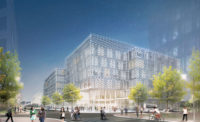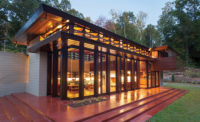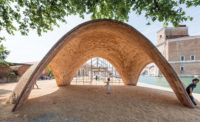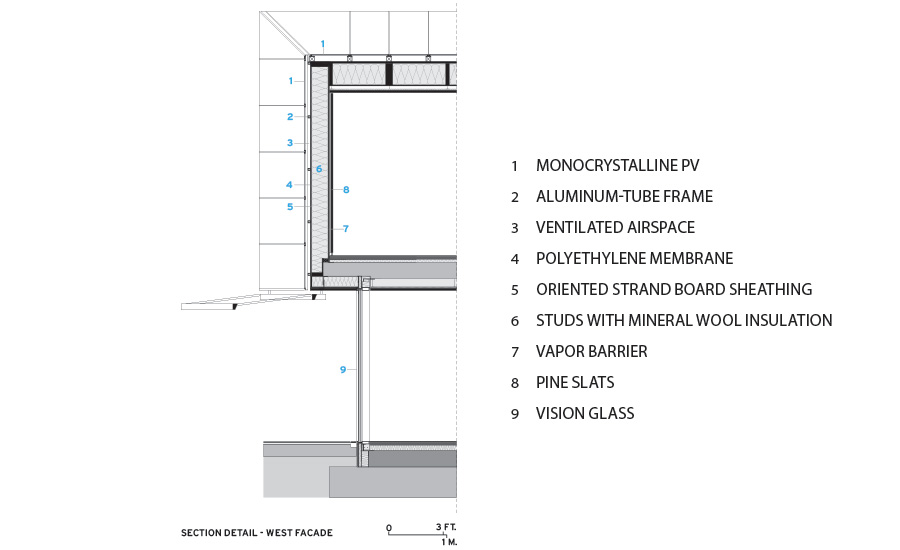Continuing Education: Building Integrated Photovoltaics
Catching Rays: A diverse set of projects demonstrates that a building’s skin can be transformed into a solar power plant.

Building Integrated Photovoltaics
The roof of the entry pavilion at SOM’s Tanjong Pagar Centre in Singapore is covered with thin-film PVs laminated between two layers of glass. Each of the almost 850 panels required its own junction box.
Image: Courtesy SOM/© Digital Mirage

Building Integrated Photovoltaics
The roof of the entry pavilion at SOM’s Tanjong Pagar Centre in Singapore is covered with thin-film PVs laminated between two layers of glass. Each of the almost 850 panels required its own junction box.
Rendering: Courtesy SOM/© Digital Mirage

Building Integrated Photovoltaics
In addition to the 770 conventional PV panels on the roof, Hegger Hegger Schleiff’s Aktiv Stadthaus apartment building in Frankfurt incorporates 348 BIPV panels into its facade. Together, the two systems generate a surplus of energy.
Photo: © Constantin Meyer

Building Integrated Photovoltaics
In addition to the 770 conventional PV panels on the roof, Hegger Hegger Schleiff’s Aktiv Stadthaus apartment building in Frankfurt incorporates 348 BIPV panels into its facade. Together, the two systems generate a surplus of energy.
Photo: © Constantin Meyer

Building Integrated Photovoltaics
The architects have kept energy consumption at the Aktiv Stadthaus low through a combination of highly integrated strategies, including heat exchangers placed in a nearby sewer tunnel to supply the heat pumps that control the temperature inside the apartments.
Image: Courtesy Hegger Hegger Schleiff

Building Integrated Photovoltaics
The zigzagging facade of Opus Arkitekten’s +e Kita, a day-care center in Marburg, Germany, allows adequate surface area for both energy-generating BIPVs and for vision glazing.
Photo: © Eibe Sonnecken

Building Integrated Photovoltaics
The curtain wall BIPV at +e Kita is part of an extremely efficient and airtight envelope. It consists of monocrystalline cells attached to the back of the exterior glass and mounted on an aluminum-tube frame.
Image: Courtesy Opus Architekten

Building Integrated Photovoltaics
Burkett Design’s Science Pyramid at the Denver Botanic Gardens includes BIPV cells and electrochromic glazing—both hexagonally shaped.
Photo: © Frank Ooms

Building Integrated Photovoltaics
Burkett Design’s Science Pyramid at the Denver Botanic Gardens includes BIPV cells and electrochromic glazing—both hexagonally shaped.
Photo: © Frank Ooms









For several decades, building integrated photovoltaics (BIPVs) have been waiting in the wings for much-anticipated fame and success. But the technology, which transforms a building’s envelope into a solar power plant, has remained a niche market since its development in the late 1970s.
Conventional photovoltaic (PV) panels, which are typically installed on a building after construction, have long been the industry favorite. In the last 20 years, average costs of PV systems have been cut in half, while global solar production has soared tenfold. But of the roughly 200 gigawatts (GW) of photovoltaic capacity worldwide, BIPV supplies only about 5 GW. This situation could soon change, however.
The demand for BIPVs, which replace standard exterior finishes with materials that incorporate photovoltaics, seems poised to take off. Studies such as a 2015 report by Technavio, a U.K.-based market research company, predict that global BIPV sales will triple by 2019, and triple again to $26 billon by 2022. Chief among the factors fueling this growth is a trend toward “truly monolithically integrated PV materials,” including BIPV shingles and tiles that can be substituted for conventional roofing products and have built-in electrical connections.
One reason for the market’s past slow growth is the limited size choice in solar cells, explains Gregory Kiss, principal at Kiss+Cathcart architects. Because buildingproduct manufacturers in the BIPV market typically rely on premanufactured solar cells, they have difficulty integrating the cells into conventional construction materials, he says. For architects like Kiss, who coauthored a pioneering study on BIPV for the National Renewable Energy Laboratory in 2000, it has often been more practical to use less expensive conventional PVs on projects such as his firm’s Bushwick Inlet Park in Brooklyn (architectural record, June 2014, page 236).
But he points out that the price of BIPVs is falling. Aditionally, they have the potential to offset some of the cost that would go into other materials and installation. In addition, there are a growing number of companies that can deliver BIPV modules of any size, shape, or color, he says.
ENERGY AND SHELTER
A project that demonstrates a higher profile for BIPV is the 64-story mixed-use Tanjong Pagar Centre, which will be the tallest building in Singapore when completed later this year. At the base of the mixed-use structure’s two conjoined steel-and-glass towers, the architects at Skidmore, Owings & Merrill (SOM) designed a 26,000-square-foot City Room Pavilion with thin film solar modules embedded in the glass canopy. The challenge of the 80-foot-tall steelframe structure was to provide the retail and public areas with protection from the intense tropical sun and heavy rain while generating power, according to SOM’s design development lead architect, Nicolas Medrano.
Typically, thin film solar modules are made by depositing an extremely thin pattern of photovoltaic silica or metal-based material onto a substrate such as glass or plastic. Their efficiency (the percentage of solar radiation converted into electricity) runs between 8 per- cent and 14 percent, depending on the composition, while crystalline cells, which are made of silicon crystals and require a heavier glass substrate, are about 20 to 25 percent efficient. Although they are less efficient, thin film modules have the advantage of being very light and flexible, allowing them to be applied to curved or even inflatable structures.
At Tanjong Pagar, SOM specified thin film PVs laminated between two layers of glass to produce a shading effect. The architects found a module that has an energy-absorbing black on the top side but is almost white on the bottom, which makes the underside appear more uniform. The result is a module that garners solar power, absorbs heat, and provides partial shade. “The canopy allows a lot of light in but lets almost no heat through,” Medrano says. He adds that plentiful daylight was important to maintain the health of the vegetation planted below the canopy.
Each of the canopy’s 848 49-by-100-inch modules requires its own junction box, integrated by the architects into the structure’s mullions. But the complexity of the system could make it hard to take advantage of betterperforming modules as they become available. And, in fact, in the two years between the construction documents phase and installation, larger and more efficient modules have come on to the market, too late in the process to adapt the canopy. A “plug and play” system that simplifies installation and facilitates upgrades could spur more demand for BIPV systems, points out Medrano.
In full sun, the canopy can produce a maximum of 149 kilowatts (KW). When combined with the 175 KW peak output of the conventional multicrystalline panels on the building’s roofs, solar satisfies 1 percent of the 1.4 million-square-foot building’s power demand. Although this sounds negligible, it should help Tanjong Pagar achieve LEED Platinum for its office portion and LEED Gold for its residential component.
TWO POWERHOUSES
In Germany, which has the ambitious goal of supplying 45 percent of the country’s energy through renewable sources by 2030, BIPV is playing an increasing role. The Aktiv Stadthaus in Frankfurt is a pilot project for Germany’s multifamily EfficiencyHousePlus standard, which requires a building to produce more energy than it consumes. Completed last summer, the eightstory structure with 74 living units occupies a 27-foot-wide by 480-foot-long site in the central district of the city.
Although the roof is covered with 770 conventional PV panels that generate up to 247 KW, the architects at Hegger Hegger Schleiff added 348 BIPV wall panels to the south facade to exceed the building’s energy needs. The project demonstrates strategies for two primary challenges for PV-powered buildings. First, what will keep the energy demand low, so that costly systems like BIPV can be minimally sized? Second, is there a way to supply power when the sun isn’t shining?
The architects were able to keep power loads in check by outfitting the apartments with extremely efficient appliances and lighting. High-performance triple-glazed windows and insulated wood-frame infill walls also contribute to the building’s low energy appetite, as do heat exchangers placed in a nearby sewer tunnel to supply the heat pumps that control the temperature inside the apartments. The project’s low energy consumption nearly meets the stringent Passive House standard of 1.7 KW per square foot annually.
Although the building is connected to the grid, the designers placed a 250 KW battery system in the basement to store excess power during daylight hours and supply energy at night when demand is often greater. This backup system also helps make the building more resilient in the event of a power outage, points out project architect Kai Erlenkämper.
About 50 miles north of Frankfurt in Marburg, a day-care center was the first building of its type to receive AktivPlus designation (another German standard requiring that on-site energy production exceed demand). Designed by Darmstadt-based Opus Architekten, the 9,900-square-foot facility, known as +e Kita, has a sawtooth roof with BIPV monocrystalline PV panels covering its south-facing slopes. As in the Aktiv Stadthaus, the designers supplemented the roof panels with BIPV wall modules in order to exceed the power demands of the building: the 52 KW system can supply about 41,000 KWh per year, while the demand is 37,000 KWh.
Unlike the thin film modules on the Tanjong Pagar project, the black monocrystalline cells used on the day-care center are more opaque and less practical for filtering daylight. Opus Architecture’s solution was to create a west facade with an upper level that takes its cues from the roof’s sawtooth. It zigzags in plan, with panels angled so that they are oriented either southwest or northwest. Those that face southwest are clad in BIPV while those facing northwest have vision glass. The scheme provides both adequate area for generating electricity and generous windows for indirect daylight and views, says project architect Andreas Sedler.
The curtain wall BIPV, which is part of an extremely efficient and airtight envelope, consists of the monocrystalline cells attached to the back of the exterior glass and mounted on an aluminum-tube frame. The frame allows for a ventilated airspace behind the PV panels— a critical detail, since the efficiency drops if heat from the cells builds up.
Although the clients from the city government had been concerned about using a wall of black PV panels on a kindergarten, they are pleased with the result. “The polished glass has a mirror effect that reflects the sky and changes color throughout the day,” says Sedler.
NEW FACETS
The BIPV system for a new interpretive science building in the Denver Botanic Gardens demonstrates that the industry is progressing toward flexibility and customization. Meant to allude to the collision of the tectonic plates that formed the Rockies, the abstracted pyramidal form of the Science Pyramid is made up of two vaulted segments separated by a strip of glazing. Completed in 2014, the honeycombpatterned skin has inserted hexagonally shaped monocrystalline BIPV cells on the south and west facades.
It took some effort for the architects at Denver’s Burkett Design to find a company to fabricate the hexagonal panels, according to Burkett’s project architect Ben Niamthet. But they eventually located a BIPV manufacturer that could make the complex shapes.
The cells are part of a rainscreen system that includes electrochromic glazing units, which automatically darken in strong daylight to shade the building’s interior. Hexagonal fiber-cement panels make up the opaque areas of the skin. A stout tubular steel structure supports a 21-inch-thick multilayered wall-and-roof assembly. A ventilated 6-inch cavity between the rainscreen and the insulated shell keeps the solar cells from overheating and helps cool the building.
The 55 BIPV panels, on both the south and the west sides, are expected to generate 9,356 KWh of electricity annually. Michael Woodhouse, a technology analyst at the National Renewable Energy Laboratory, explains why placing PVs on multiple facades can be a good strategy, even though the optimal orientation in the northern hemisphere is to the south, at an average angle perpendicular to the sun’s rays.
An orientation solely to the south doesn’t always provide the right amount of power at the right time, he explains. An east or west configuration can fill the energy production “shoulders”—times when a south-facing module’s output falls off. This strategy can benefit the occupants by changing the production profile over the course of the day and can simulate expensive tracking devices that mechanically adjust the PVs to the optimum energy-generating orientation.
A SUNNY FUTURE
One bright spot for BIPV is the number of recent advances in research and development. Commercial thin film materials tend to be expensive, and many contain toxic heavy metals. Organic photovoltaic (OPV) cells show promise as an inexpensive, more environmentally friendly alternative, according to Woodhouse. Organic, in this case, refers to photovoltaic materials composed of common elements such as carbon, hydrogen, and oxygen. In recent laboratory tests by the German company Heliatek, OPV achieved an efficiency of 13.2 percent. Mass production of such OPV films, which are not yet readily available, could bring the concept of cloaking more structures in BIPV closer to reality.
Another promising technology is the white and colored crystalline solar modules developed by the nonprofit Swiss research organization CSEM. The surface of the modules allows energy-producing infrared light through while scattering selected parts of the spectrum. In addition to having the ability to be produced in any color, the opaque surface treatment obscures the cells and wiring to create a monolithic appearance. The film could be used on any conventional panel and for retrofitting an existing system.
A number of companies are also manufacturing solar glazing—a transparent or tinted photovoltaic coating applied to glass. This product allows PVs to be used in place of typical vision glass.
The cost of generating electricity with PVs is now competitive with fossil fuels in many U.S. markets. But for BIPV, the question remains: will lower costs and innovation give the industry the kind of momentum needed to push it into the mainstream? “We have some catching up to do with Europe,” Gregory Kiss says, “but I’m optimistic that BIPV will someday constitute a substantial portion of the cladding for our buildings and infrastructure.”
|
Continuing Education

To earn one AIA learning unit (LU), including one hour of health, safety, and welfare (HSW) credit, read “Catching Rays,” review the supplemental material listed below, and complete the online test. Upon passing the test, you will receive a certificate of completion, and your credit will be automatically reported to the AIA. Additional information regarding credit-reporting and continuing-education requirements can be found online at continuingeducation.bnpmedia.com.
Supplemental Material Patrina Eiffert, Ph.D., Gregory J. Kiss
Learning Objectives 1 Explain the difference between PVs and BIPVs. 2 Describe the performance properties of thin-film and crystalline solar cells and explain how they are made. 3 Explain the strategies employed on recent projects intended to maximize BIPV power production. 4 Describe new BIPV technologies.
AIA/CES Course #K1604A
For CEU credit, read "Catching Rays" and take the quiz at continuingeducation.bnpmedia.com, or use our architectural record continuing-education app, available in the itunes store.
structure, finishes, and other original fabric when
a building is moved.
significant buildings.
|












